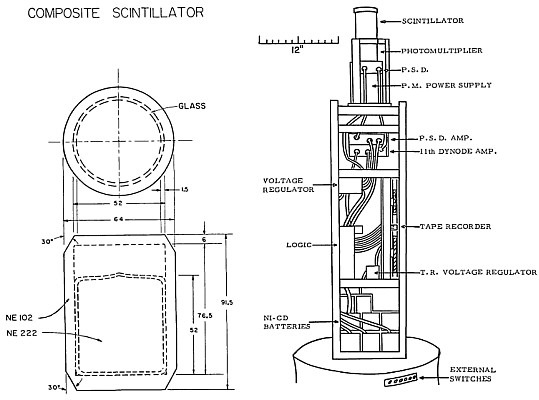Purpose of the flight and payload description
The fast neutron detector was an instrument aimed to measure 1-10 Mev recoil-proton and heavily ionizing events produced by neutrons in an organic scintillator. The detector itself is a 5 cm x 5 cm cylindrical volume of organic liquid phosphor, which is surrounded by a 6 mm minimum thickness of plastic scintillator which acts as an anticoincidence shield for charged particles. The composite detector is viewed by a single 5 cm photomultiplier. The set is shown in the far left scheme.
Events produced in the composite scintilator by radiation other than neutrons (like protons and electrons produced by background radiation and gamma rays) are rejected by the detector electronics on the basis of pulse shape. The pulses produced by scintillations of recoil-protons between 1 and 10 MeV are amplified, gated as neutron events and sorted in a seven-channel pulse height analyzer. The seven channels of pulse height information are binary coded and recorded on three tracks of a four track magnetic tape recorder. The fourth track contains a time signal as well as a record of all events produced in the scintillator with a light output greater than that of 1 MeV proton. Ambient pressure, the temperature of the gondola, and time are registered by a photobarograph which also acts as a backup system for the tape recorder, registering the counts in neutron channels 1-5 and 4-7 and in total events.
The instrumented rack (shown in the far right scheme) was designed so that the mass distributed in the balloon gondola would subtend a minimal solid angle at the scintillator. This was to prevent background neutrons produced by high energy radiation in the local material, from reaching the detector. An exterior container housed the photobarograph and the batteries for the heaters in the gondola. Such heaters were required only during night flights, since the insulation, made of 10 cm of polyurethane foam, and the reflectivity of the yellow fiberglas gondola were sufficient to maintain the inside temperature.
Details of the balloon flight
Balloon launched on: 8/9/1965 at 22:33 utc
Launch site: Fort Churchill Airport, Manitoba, Canada
Balloon launched by: Schjeldahl
Balloon manufacturer/size/composition: Zero Pressure Balloon Winzen 2.940.000 cuft - (0.7 mils - Stratofilm)
Flight identification number: NYU 111P
End of flight (L for landing time, W for last contact, otherwise termination time): ??/??/1965
Balloon flight duration (F: time at float only, otherwise total flight time in d:days / h:hours or m:minutes - ): 17 h 45 m
Payload weight: 507 lbs
At the time of the balloon termination, it was flying near a thunderstorm and as a result, the gondola was lost. However it was found in the backwoods of Canada after a year. The equipment was corroded, but the tape was still readable and the data was retrieved.
External references
- SKYHOOK series, Partial Flight Record (July 28 - September 8, 1965) Scientific Ballooning Nº 21, December 1965
5925If you consider this website interesting or useful, you can help me to keep it up and running with a small donation to cover the operational costs. Just the equivalent of the price of a cup of coffee helps a lot.


